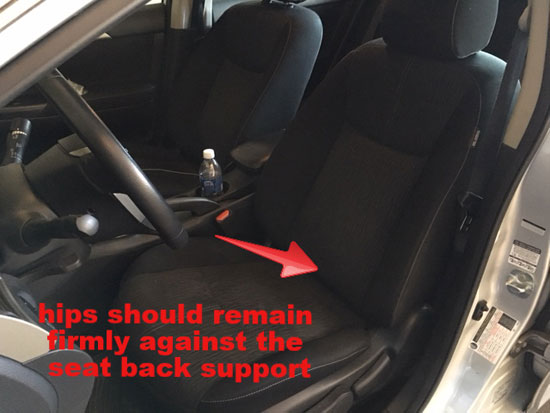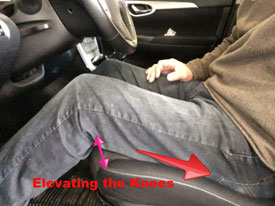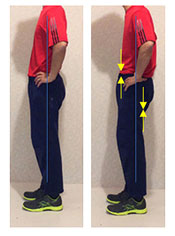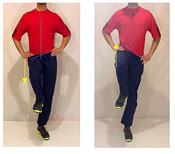Why your back hurts when driving & how to Stop it

You want to keep both legs evenly positioned in front of you and not slanted to one side.
Sherwin Nicholson| Updated May 7, 2020
Why does my back hurt so much when I drive?
For the 2 simple exercises that will help you, scroll down to begin.
If it hurts every time you sit in the car, you’re not alone.
Driving while you are constantly in pain is one of the most common problems to have. It doesn’t take long before it starts to hurt while you drive. If it happens before you get into the seat, you’ll need to make some of these important adjustments each day to feel better.
Even passengers can suffer on long drives because their own seat and position can be just as uncomfortable. So this information will also help them too.
Before you start, you should know what may be the cause and what is going on?
Please note: You may have disc issues, vertebral, facet joint or muscle imbalances that become more painful when driving. What happens as you drive with these issues will help you to pinpoint what you can do.
Here are some tips on what you can do to suffer less pain when your drive.
There are 3 possible scenarios that affect your drive
1. Your body can be conditioned and well protected. However, the limitations and flaws of the vehicle and seat cause your balanced, healthy back to become prone to injury.
2. Your back already has issues, but the vehicle and seat provide full support and protection but fail to fix the problem.
3. You have both. Both back problems and operate a vehicle with inadequate support causing your discomfort to become worse with few solutions.
Falling within one of these three categories is easy.
It’s true that there are many causes and finding a single method of treatment is hard BUT it is very easy to find suggestions on how to drive with minimal pain.
There is rarely a magic bullet where a simple adjustment to the vehicle or your posture will help right away but when you practice them often enough, you will notice improvements.
Here are some important suggestions to help you when driving. These suggestions are not as well known but effective.

Elevate to allow circulation but keep the knees safely from the front panel
Follow These 3 Tips Whenever You Drive
1) Elevate Your Legs/Knees
When seated, position yourself in your chair so that your thighs (and knees) are slightly elevated off of the edge of the seat while your knees are bent (purple arrow).
Elevating allows for and restores adequate blood flow up to your buttocks/glutes (red arrow). Without proper circulation to your muscles and nerves, your legs will become tired and will lack support for you while seated and standing.
I would like to caution you about seat adjustments. Although you will need to adjust your seat so that you should elevate your knees, make sure that your knees are not too close to the steering column and dash. You need to keep some distance in the event of a crash. You don’t want to severely injure your knees during a collision.
This is a first step in strengthening your leg muscles to support your spine.
2) Watch Your Seat Belt Tensioner
A little known source of injury. The seat belt tensioner is that little self adjustment device that securely brings your lap portion of the belt taught with your waistline.
A good one will comfortably protect you without you feeling it. A bad, one however will constantly apply increasing tension and will force a posterior pelvic tilt on you. This will make you slouch more than you realize and may hurt your discs. Be very conscious of your tensioner and place it as low as possible.
If you are feeling sore when you drive, check your belt tension often.
3) Sit Firmly Back Into the Chair
Sit with your legs pointed straight forward and keep your bum firmly rested against the upright part of your seat. See the large red arrow in the top above image.
Sitting as upright as possible will protect you from slouching and becoming more and more sore as you drive. You have to vigilantly check for this every 5-10 minutes because it’s so easy to slouch. Slouching while the tensioner is on you will add to your misery.
The benefit of keeping your butt firmly against the seat is that it help to keep your pelvic tilt neutral. This hurts much less and will help you to have a more comfortable drive.
If you can do this well, you won’t need an extra cushion or lumbar support for your car seat.
Note: Sitting at work can be just as painful so follow these 5 important tips that you can use while at your desk.
Learn These 2 Great Exercises So You Can Drive With More Relief
(You can also find more exercises in the 10 Exercises for your back Section.)
1) The Standing Abdominal Exercise
It helps with the following:
- It encourages you to maintain a safe posture
- Maintains both neutral lumbar and pelvic tilt posture
- Stretches and strengthens the hips
- Provides strength to the abdominals
Click on the Image or HERE for full instructions
2) The Standing Hip Shift Exercise
It helps with the following:
- Encourages your gluteus maximus to contract
- Strengthens your gluteus medius
- Strengthens the deeper muscles for the spine
- Strengthens the abdominals
Click on the Image or HERE for full instructions
By working through the stiffness, tightness, and weak muscles that these exercises address, you will be on a path to further relieve your pain.
Here are some more suggestions that work:
10 Exercises for Lumbar and Hip Pain
Understand that these exercise are just the beginning. You will need to loosen your tight hips, strengthen your abs, relax the tension, stretch your hamstrings and last but not least, begin hip shifting to free up your tight hip joint.
If this is too overwhelming and confusing, then begin here with a comprehensive and thorough set of simple exercises to help you.
For more help:
- How work causes your pain.
- Too much sitting leads to ‘adaptive shortening’.
- Is your sitting causing pins and needles?
- Driving can easily irritate the nerves in your spine causing a sharp radicular pain as in sciatica.
References:
- Solving Back Problems – Dr. J. Sutcliffe. Timelife Custom Publishing. Health Fact File. 1999. RD768S82
- LBP – Denise M. Goodman, MD, MS; Alison E. Burke, MA; Edward H. Livingston, MD JAMA. 2013;309(16):1738. doi:10.1001/jama.2013.3046 http://jamanetwork.com/journals/jama/fullarticle/1681414
- LBP – Eric R. Castillo Daniel E. Lieberman Evol Med Public Health (2015) 2015 (1): 2-3. DOI:


